
Function Reference
The order of functions in this API reference goes according to the chronological order of which they are called in the native LEOGPS processing work flow (see previous page). Functions that are currently not in use in the current native work flow are listed at the end of this page.
spacecraft.py
Spacecraft object
- class spacecraft.Spacecraft(elements=None, states=None, epoch=None, forces=None, attBN=None, ohmBN=None, attBR=None, ohmBR=None, name=None, mass=None, area=None, Cd=None, GM=None)
Initialise a spacecraft object with state attributes, attitude attributes, angular velocities, and area-mass parameters.
- elements
List of 6 Keplerian elements [a, e, i, R, w, M].
- Type
list (optional)
- states
List of 6 Cartesian states [px, py, pz, vx, vy, vz].
- Type
list (optional)
- mass
Drag mass of spacecraft (kg). The default is 1.
- Type
float, optional
- area
Drag area of spacecraft (m^2). The default is 0.
- Type
float, optional
- Cd
Dimensionless drag coefficient. The default is 2.2.
- Type
float, optional
- name
Custom name for the spacecraft object.
- Type
str, optional
- GM
Product of planet mass and gravitational constant (km**3/s**2)
- Type
float, optional
attitudes.py
Attitude file containing attitude classes (quaternions, classical rodrigues parameters and modified rodrigues parameters).
Created on Tue Nov 23 16:18:36 2021
@author: sammm
- class attitudes.QTR(qtr=None, dcm=None)
A Quaternion (QTR) class can be initialised with either a 1x4 NumPy array, or a direction cosine as a 3x3 NumPy array.
- Parameters
qtr (TYPE, optional) – DESCRIPTION. The default is None.
dcm (TYPE, optional) – DESCRIPTION. The default is None.
This API reference was automatically generated using Sphinx’ Autodoc feature, using the NumPy docstring format, and last updated on 11th September 2021.